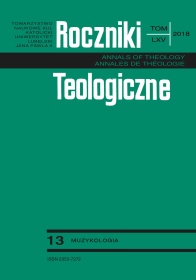Organ Pipes and Tuning of Organ According to the Treatise of Arnolt Schlick „Spiegel der Orgelmacher und Organisten” from 1511
Abstract
Analysis of Spiegel der Orgelmacher und Organisten (1511) has proven that in Schlick’s time organ pipes were most often constructed of tin, lead, an alloy of both of wood. A. Schlick, confirms also that attempts had been made to create pipes out of paper, cloth (silk) and glass. He refers to the size and voicing of the pipes. Regarding the scaling Schlick sees the following relation: the larger the diameter of the pipes, the shorter the corpus (especially in comparison with a narrower corpus of a pipe sounding at the same pitch). He also points that narrow-scaled pipes hat a sweeter tone (süsser) that wider pipes. He also makes a proposal of to dividing the octave into smaller intervals (different than in the Pythagorean system). Schlick’s system is in the modern theory called the meantone temperament (Mitteltönigkeit).
References
Anhagen W., Stimmung und Temperatur, w: Die Musik in Geschichte und Gegenwart. Sachteil, red. L. Finscher, Bd. 8, Kassel 1998, k. 1838-1847.
Billeter B., Anweisung zum Stimmen von Tasteninstrumenten in verschiedenen Temperaturen, Berlin 1979.
Chwałek J., Budowa organów. Wprowadzenie do inwentaryzacji i dokumentacji zabytkowych organów w Polsce, cz. I: tekst, „Biblioteka Muzealnictwa i Ochrony Zabytków”, t. XXXI, Warszawa 1971 [Lublin 1972²].
Drobner M., Systemy i skale muzyczne, Kraków 1982.
Frotscher G., Geschichte des Orgelspiels, Bd. 1, Berlin 1959.
Grabner H., Die Kunst des Orgelbaues, Berlin 1958.
Klinda F., Orgelregistrierug. Klanggestaltung der Orgelmusik, Leipzig 1987.
Marx H.J., Schlick Arnolt, w: The New Grove Dictionary of Music and Musicians, ed. S. Sadie, vol. 22, London 2001, s. 522-523.
Mocarski W., Akordyka „Fiori musicali” Girolamo Frescobaldiego w świetle renesansowych systemów strojenia instrumentów, Lublin 1997 (mps pracy magisterskiej w Arch. KUL).
Pietrzyk A., Strojenie organów według „Musica Mechanica Organoedi” Jakoba Adlunga, w: Artificium Ars Scientia. Księga Jubileuszowa w 80. rocznicę urodzin Ks. Profesora Jana Chwałka, red. M. Szymanowicz, Lublin 2010, s. 193-233.
Pietzsch G., Quellen und Forschungen zur Geschichte der Musik am kurpfälzischen Hof zu Heidelberg bis 1622, Akademie der Wissenschaften und der Literature, Wiesbaden 1963.
Pilch M., Stroje historyczne w teorii i praktyce, cz. II: Just Intonation, „Notes Muzyczny” 2015, nr 1(3), s. 57-81.
Poźniak P., Schlick Arnolt, w: Encyklopedia Muzyczna PWN. Część biograficzna, red. E. Dziębowska, t. 9: s-sł, Kraków 2008, s. 107.
Reichert P., Orgelbau. Kunst und Technik, Wilhelmshaven 1995.
Sachs C., Historia instrumentów muzycznych, tłum. S. Olędzki, Kraków 1989.
Sapalski A., Przewodnik dla organistów, Kraków 1880.
Schlick A., Spiegel der Orgelmacher und Organisten, Translation and notes by E.B. Barber, First Knuf, Buren 1980.
Szymanowicz M., Zabytkowe organy w województwie radomskim, Warszawa 1998.
Toporowski M., Sposoby strojenia oraz charakterystyka mezotonicznych i „dobrych” temperacji, w: Dawne temperacje. Podstawy akustyczne i praktyczne wykorzystanie, red. M. Toporowski, Katowice 2014, s. 73-118.
Towarek P., Postulaty organmistrzowskie Arnolta Schlicka w traktacie „Spiegel der Orgelmacher und Organisten” z 1511 roku, Lublin 2004 (mps pracy magisterskiej w Arch. KUL).
Towarek P., Arnolta Schlicka traktat „Spiegel der Orgelmacher und Organisten” z 1511 roku, „Studia Elbląskie” 2004-2005, nr 6, s. 191-216.
Towarek P., Cechy zewnętrzne organów w świetle traktatu „Spiegel der Orgelmacher und Organisten” z 1511 roku, „Studia Elbląskie” 2010, nr 11, s. 373-381.
Towarek P., Głosy organowe w świetle traktatu „Spiegel der Orgelmacher und Organisten” [1511], „Studia Elbląskie” 2017, nr 18, s. 245-259.
Copyright (c) 2018 Roczniki Teologiczne

This work is licensed under a Creative Commons Attribution-NonCommercial-NoDerivatives 4.0 International License.





